서 론
침샘종양은 두경부에 생기는 종양의 2~6.5% 정도를 차지하며,1) 침샘의 악성종양은 전체 암 중 약 0.3%를 차 지한다.2) 이러한 침샘종양은 그 빈도에 비하여 조직학적 아형의 수가 많고, 아형끼리 비슷한 조직소견을 공유하 기도 하며, 또한 한 아형 내에서도 다양한 모습을 나타 낼 수 있어서 정확한 병리학적 진단이 매우 힘들다.2-5) 특히, 일부 아형을 제외하고는 발생 빈도가 드물어서 두 경부병리를 전공하는 병리의사조차도 모든 아형을 경 험하기는 쉽지 않은 실정이다. 이러한 침샘종양의 병리 학적 진단은 세계보건기구(World Health Organization, WHO) 분류에 따라 이루어지고 있으므로, 임상의 사와 병리의사는 모두 이 분류에 대해 비교적 잘 알고 있을 필요가 있다.6)
2017년에 개정된 WHO 두경부종양 분류에 따르면 상피기원의 침샘종양은 양성종양 11종과 악성종양 19 종으로 나눌 수 있다(Table 1).6) 침샘기원의 양성종양 중 비교적 흔한 아형으로 다형선종(pleomorphic adenoma), Warthin 종양, 기저세포선종(basal cell adenoma)이 있으며, 악성종양은 다형선종유래암종(carcinoma ex pleomorphic adenoma, CXPA), 점액유상피암 종(mucoepidermoid carcinoma), 편평세포암종(squamous cell carcinoma), 선낭암종(adenoid cystic carcinoma), 침샘관암종(salivary duct carcinoma), 세엽세 포암종(acinic cell carcinoma) 등이 있다. 악성종양은 다시 고등급과 저등급으로 분류할 수 있으며, 침샘관암 종, 고등급 점액유상피암종, 편평세포암종, 다형선종유 래암종 등이 대표적인 고등급 암종이다. 특히, 2017년 WHO 분류에서는 분비성 암종(secretory carcinoma), 관내 암종(Intraductal carcinoma)이 새롭게 추가되었 다. 임상의사와 병리의사 간의 원활한 소통을 위하여, 비교적 흔히 만날 수 있는 침샘종양의 병리학적 소견에 대해 알아보고자 한다.
다형선종은 침샘종양 중 가장 흔한 종양으로, 전체 침 샘기원 종양의 2/3 정도를 차지하며 주로 귀밑샘에서 발 생한다.1,6,7) 특징적으로 종양 내에 상피성 성분과 간질성 성분이 모두 관찰된다. 상피성 성분은 두 가지 세포 즉 상피세포와 근상피세포(myoepithelial cell)로 구성되며, 이들이 샘구조를 형성할 때, 상피세포는 내강 쪽에 위치 하며 근상피세포는 외측에 위치하여 기저막과 인접하게 된다. 근상피세포는 종양세포이며, 상피양(epithelioid), 형질세포형(plasmacytoid), 방추형(spindle), 투명세포의 형태를 취할 수 있으며, 점액성 및 연골성 기질을 생산 한다. 육안적으로 비교적 경계가 좋으며 절단면은 번질 거리는 특징이 있다(Fig. 1A). 세침흡인세포검사에서는 상피세포 및 근상피세포와 특징적인 기질을 보고 진단 할 수 있다(Fig. 1B).1,8,9) 조직소견에서 다양한 정도의 상 피성분과 기질성분의 조합을 볼 수 있다(Fig. 1C, D). 피 막을 가지고 있으며 경계가 좋은 편이지만 부분적으로 피막이 소실되어 주위 조직으로 침윤하는 것처럼 보일 수 있으므로 악성으로 오인하지 않도록 주의해야 한다. 다형선종은 양성종양이지만 매우 드물게 전이가 보고된 바 있다. 재발은 불완전절제 때문이며 완전절제 후의 재 발율은 매우 낮은 것으로 알려져 있다.1,6-8)
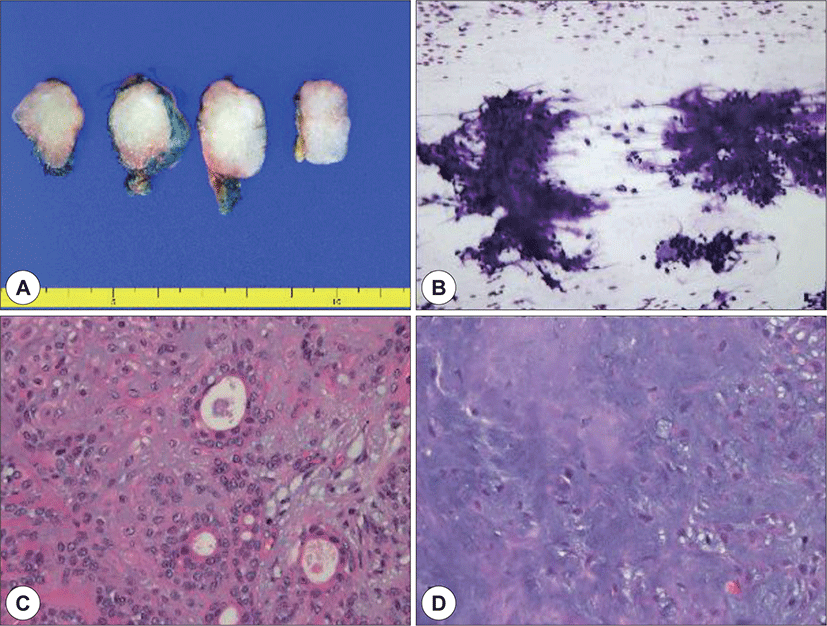
다형선종에서는 드물지 않게 상피성분이 악성변화를 하여 악성종양이 발생하는데, 이를 다형선종유래암종이 라고 한다.1,6,8,11) 이 악성종양의 조직학적 아형에는 선암, adenocarcinoma, not otherwise specified(NOS), 점액유 상피암종, 침샘관암종 등이 포함된다.1,6-8) 다형선종유래 암종은 피막내형(intracapsular), 미세침윤형(minimally invasive), 광범위침윤형(widely invasive)으로 나눌 수 있는데,1,6-8) WHO 기준에 의하면 악성종양이 다형선종 의 피막 내에 국한되어 있을 때는 피막내형, 피막에서 1.5 mm 이하로 침윤했을 때는 미세침윤형, 1.5 mm 이 상일 때는 광범위침윤형으로 분류한다.1,6-8) 피막내형과 미세침윤형인 경우에는 다형선종과 예후가 거의 비슷한 것으로 알려져 있으나, 광범위침윤형일 경우는 불량한 예후를 보이게 된다.1,6-8) 다만, 근상피암(myoepithelilal carcinoma)은 피막내형 혹은 미세침윤형일 때도 원격전 이를 하는 등 좋지 않은 예후를 보이는 것으로 알려져 있다.10) 다형선종유래암종에서 악성변화가 일어난 부분 이 크지 않고 여전히 다형선종이 대부분인 경우라면 수 술전 세침흡인세포검사나 중심바늘검사에서 위음성을 나타낼 수 있다.
다형선종에 이어 두번째로 흔한 침샘의 양성종양이 다.1,6,8) 남자에서 더 많이 발생하고 흡연과의 연관성이 높다.1,6,8) 림프종성유두낭선종(papillary cystadenoma lymphomatosum)이라는 이름으로도 불려지듯이 호산 성과립세포(oncocyte)가 유두상으로 자라며, 풍부한 림 프구가 간질조직에 분포한다.1,6,8) 육안적으로는 낭성 변 화를 보이는 경우가 흔하다(Fig. 2A). 세침흡인세포검사 에서 호산성과립세포가 림프구와 함께 관찰될 때 진단 할 수 있다(Fig. 2B).1,9) 조직학적으로는 불규칙한 낭성 구조 내로 유두상 돌기가 돌출하며, 이러한 낭성구조와 돌기는 두 층의 상피세포로 피복된다(Fig. 2C, D). 이들 상피세포는 미토콘드리아 증가에 의해 호산성의 풍부한 세포질을 가지게 되며, 작지만 뚜렷한 핵소체를 가지고 있다. 간질에는 림프성 조직이 두드러지게 관찰되는데, 작은 림프구와 함께 형질세포, 조직구, 비만세포로 구성 되어 있다. 상피세포는 화생변화를 보일 수 있으며, 편평 상피(squamous epithelium), 점액세포(mucous cell), 섬 모상피(ciliated epithelium)로 변화하기도 한다. 매우 드 물게 이러한 상피가 악성변화를 할 수 있다.1,6,8)
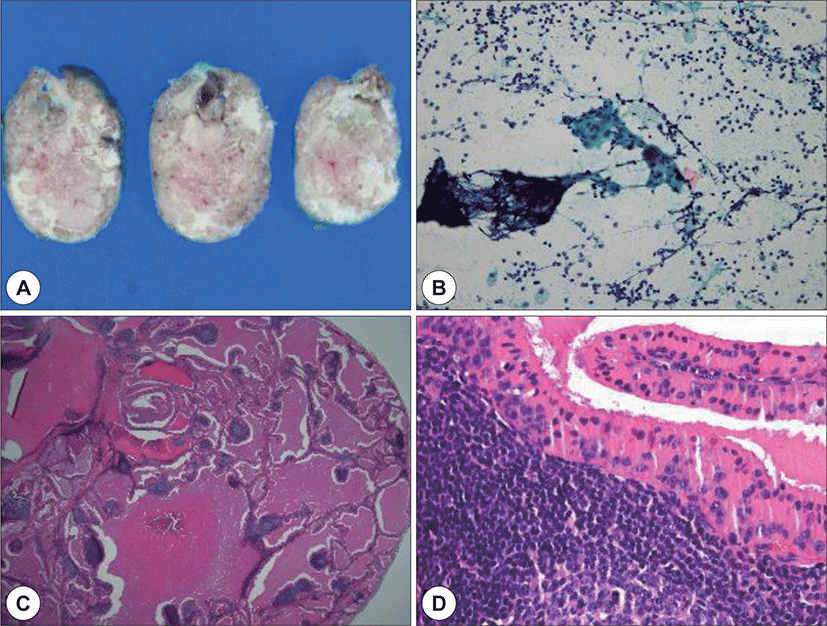
기저양세포(basaloid cell)로 구성된 양성종양으로 귀 밑샘에서 가장 호발한다.1,6,8) 육안소견에서 경계가 좋고 피막이 있으며 균질한 단면을 가지고 있는데, 저배율 소 견에서도 이를 확인할 수 있다(Fig. 3A). 종양세포가 고 형(solid), 소주형(trabecular), 관형(tubular) 모양으로 성 장할 수 있으며, 이런 구조물의 변연부에서는 핵의 울타 리 배열(peripheral palisading)을 관찰할 수 있다 (Fig. 3B, C). 간질에는 방추형 세포가 풍부하며, 간질의 양은 다양하다. 종양세포의 핵은 균일하고 타원형이며, 염색 질이 진하고 고르다. 핵소체는 뚜렷하지 않다. 악성형인 기저세포선암종(basal cell adenocarcinoma)은 매우 드 문 편이며, 기저세포선종과 세포조직학적 소견이 비슷하 여 감별하기 어렵다. 감별점은 기저세포선암종은 주변조 직으로의 침윤을 보인다는 점인데(Fig. 3D), 세침흡인세 포검사나 중심바늘생검 등에서는 이러한 소견을 확인하 기 어려워 기저세포선종으로 진단될 수 있다.12) 임상의 사는 이러한 검사의 한계를 염두에 두고 있어야 한다.
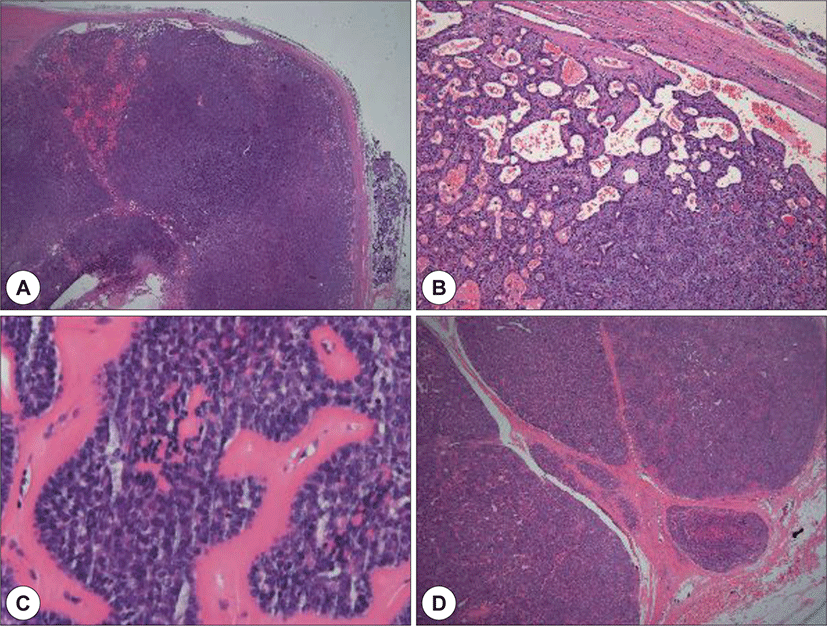
전체 침샘종양의 1% 이하를 차지하는 드문 종양으로 근상피세포로부터 유래한다.1,6,8) 육안적으로 경계가 좋 으며, 종종 다양한 두께의 피막을 가지고 있다(Fig. 4A, B). 근상피세포는 방추형, 형질세포양, 상피양 형태를 취할 수 있으며, 투명한 세포질을 가지기도 한다(Fig. 4C).1,6,8) 부분적으로 점액성 간질이 존재할 수 있어 다 형선종과의 감별에 어려움을 겪게 된다.1,6,8) 근상피종의 경우에는 다형선종과 달리 샘구조가 관찰되지 않으며, 연골성 간질이 존재하지 않는다.8) 면역조직화학염색에 서 S100 단백, SMA, calponin, p63 등에 양성을 나타낸 다(Fig. 4D). 악성형인 근상피세포암은 침샘암의 2% 미 만을 차지하는 매우 드문 암인데, 세포의 이형성, 유사 분열, 괴사 등의 소견이 저명하지 않을 경우 양성으로 오인되기 쉽다.11,13)
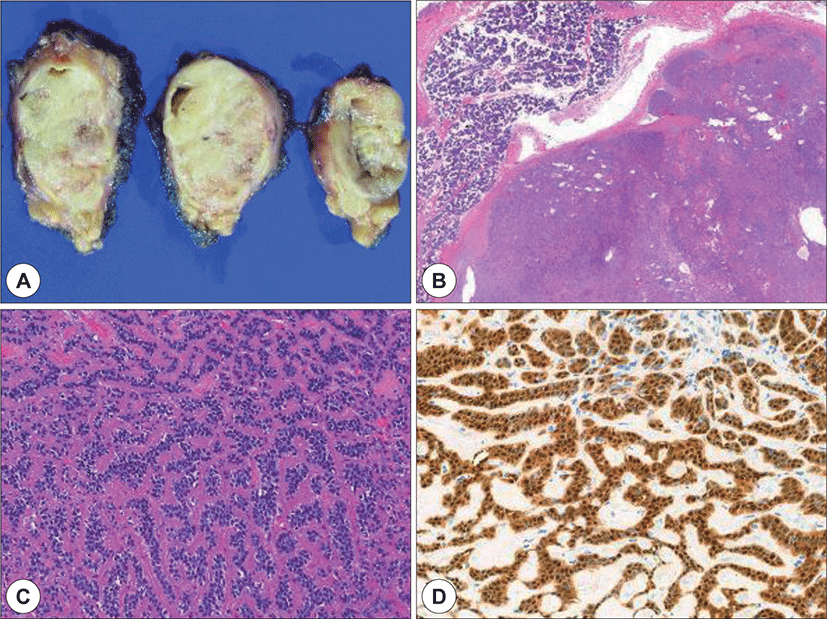
점액유상피암종은 3분의 2가 귀밑샘에 발생하며, 다 양한 연령대에 걸쳐 발생하는 경향이 있다.1,6,8,13-15) 특히 어린이 및 청장년 층에서 가장 흔한 침샘의 악성종양이 다. 부분적으로 피막을 형성하기도 하며, 침윤적 성장을 보인다. 종양세포는 점액세포, 유표피세포(epidermoid cell), 중간세포(intermediate cell), 투명세포(clear cell)의 네 가지 세포로 구성된다(Fig. 5A). 이런 세포들은 점액 을 함유하는 낭성구조를 이루기도 한다(Fig. 5B). 일반적 으로, 종양세포의 배열, 핵의 이형성 정도, 신경침범 유 무, 괴사의 유무 등에 따라, 저등급(low grade), 중간등급 (intermediate grade), 고등급(high grade)으로 나눈다. 저 등급에서는 다양한 크기의 낭성 구조물과 함께 점액세 포가 많이 관찰된다(Fig. 5C). 고등급의 경우에는 낭성보 다 고형성 구조가 흔하고, 편평상피 성분이 현저한 경향 이 있다(Fig. 5D). 고등급의 경우 국소재발률이 높고 원 격전이가 빈번하다.1,6,8)
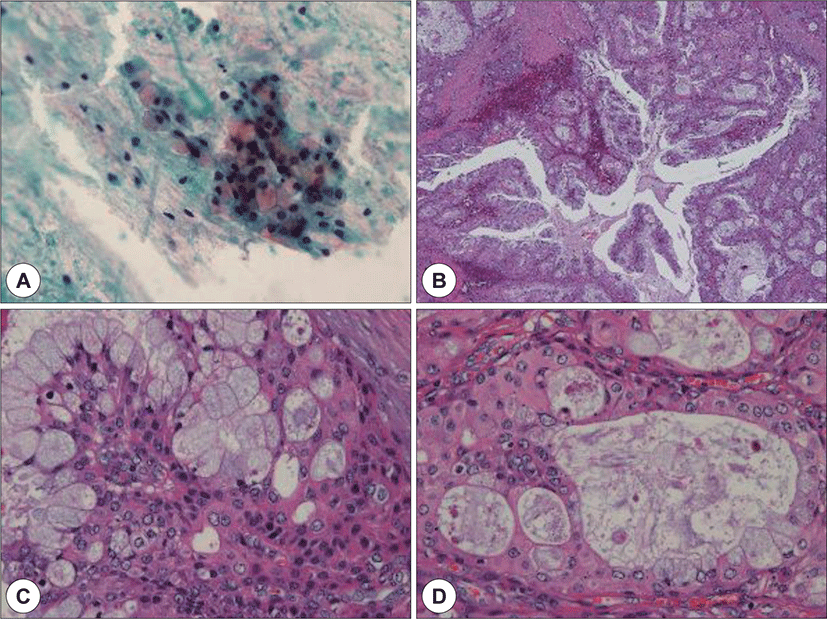
선낭암종은 침샘의 악성종양 중에서 10% 미만을 차 지한다.6) 세침흡인검사에서는 작고 일정한 모양의 세포 가 관찰된다. 핵은 원형 혹은 난원형이다(Fig. 6A).1,9) 세포군집에서 특징적인 호산성의 무정형 물질이 낭성 구조물 안에서 관찰될 수 있다. 조직소견에서는 기저양 세포가 체모양(cribriform), 관상(tubular), 고형(solid) 형태로 배열된 구조를 볼 수 있다(Fig. 6B, C). 특징적으 로 신경초를 따라서 주변 조직으로 쉽게 침윤하며, 재 발이 흔하다(Fig. 6D).1,6,8)
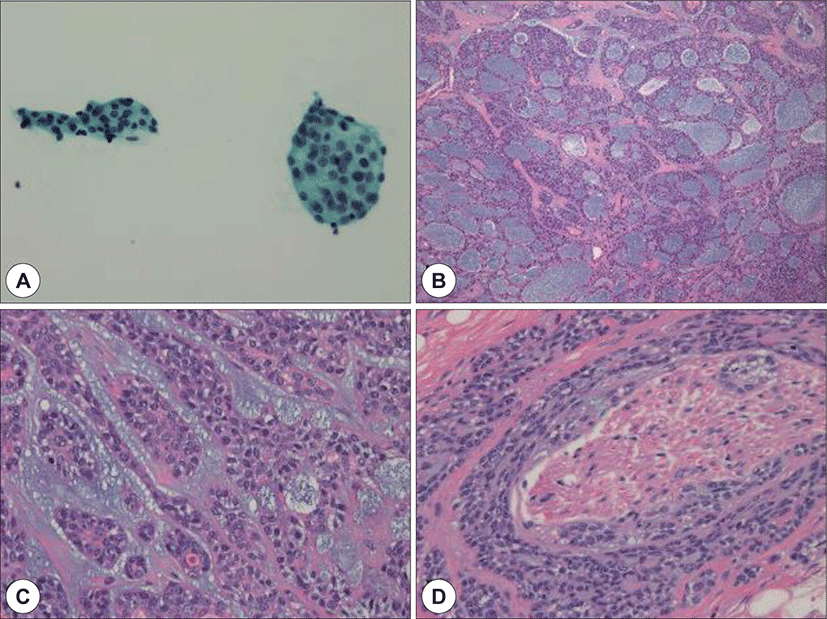
침샘관암종은 침샘암의 10% 정도를 차지한다.6) 60~70 대에서 호발하며, 남자에서 더 흔하다. 80% 이상이 귀밑 샘에서 발생한다.1) 세포도말에서 고등급의 악성세포가 관찰되므로 어렵지 않게 악성으로 진단할 수 있다(Fig. 7A). 대개 종양세포가 낱개로 흩어지거나 군집으로 나타 나는데, 체모양 혹은 가성유두(pseudopapillary) 형태로 나타날 수 있다. 종양세포의 핵은 크기가 크며, 불규칙하 고 두꺼운 핵막과 뚜렷한 핵소체를 가진다. 세포질은 풍 부하며 호산성을 띈다.

조직소견에서 종양은 경계가 불분명하고, 면포괴사 (comedo necrosis)를 동반한 유방의 관내암종(intraductal carcinoma) 혹은 침윤성 관암종(infiltrating ductal carcinoma)과 유사하다. 관내암종과 유사한 부 분은 체모양, 유두-낭성, 고형 형태를 보일 수 있으며, 괴사가 현저할 수 있다(Fig. 7B). 형태학적으로는 관내 암종을 닮기는 했지만, 이러한 부분들은 실제로는 침윤 성 암의 일부이다. 세포도말소견과 마찬가지로 고등급 의 종양세포를 관찰할 수 있다(Fig. 7C).
침샘의 악성종양 중 네번째로 흔한 암으로 주로 귀밑 샘에서 발생한다.14-16) 광범위 절제술 뒤에도 10% 정도 에서 재발하지만, 장기적인 예후는 좋은 편이다.1,6,8) 세 포도말 소견에서는 종양세포가 선방(acinar), 선형(linear), 혹은 샘(glandular) 구조를 형성한다(Fig. 8A).9) 이 들 종양세포는 정상적인 세엽세포보다 크기가 크고 모 양과 크기가 다양하며 흐릿하거나 과립성의 세포질을 가지고 있다. 조직학적으로는 침샘의 정상 장액세포보 다 큰 종양세포가 판형(sheet), 소낭성(microcystic), 관 상(tubular) 구조를 이루며 자란다(Fig. 8A-D).1,6,8) 드물 게 분화가 좋은 세엽세포암종에서 역분화(dedifferentiated) 암이 발생하기도 하는데, 악성도가 높은 세포로 구성된다.
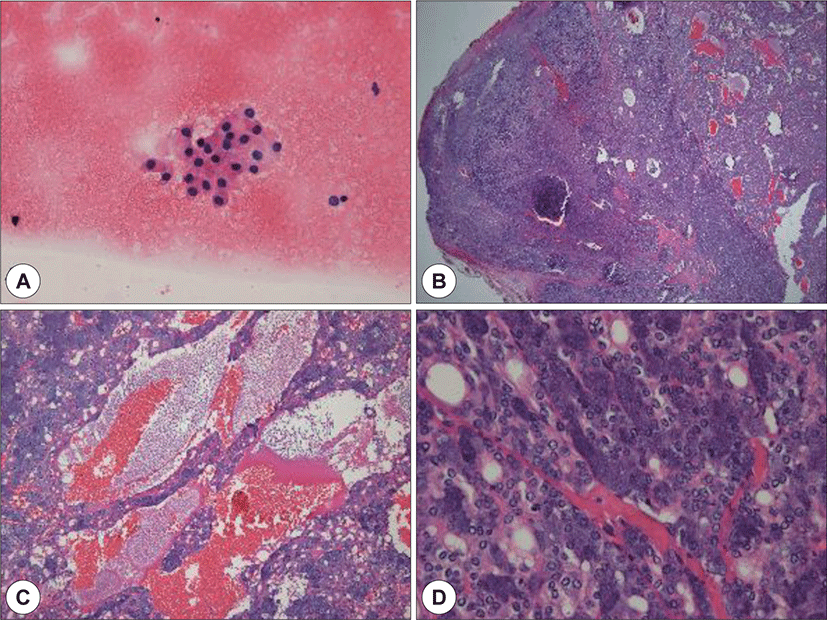
도관세포(ductal cell)와 근상피세포(myoepithelial cell)의 두 가지 세포로 구성되는 비교적 드문 저등급의 암이다. 저등급의 암으로 예후가 비교적 좋아서 10년 생존율이 80% 정도이다. 특징적으로 두 층의 세포로 구 성되는 관구조를 볼 수 있는데 내강쪽에는 도관세포가 위치하고 바깥층에는 근상피세포가 둘러싸게 된다. 도 관세포는 둥글고 비교적 일정한 모양의 핵을 가지고 있 으며, 근상피세포는 다각형이며, 풍부하고 투명한 세포 질을 가지고 있다. 세포도말에서도 이 두 가지 세포를 관찰할 수 있는데, 이형성이 심하지 않아 양성으로 오 인할 수도 있다.9,17) 조직소견에서는 침윤성 성장이 악 성임을 판단하는 중요한 단서가 된다.
새롭게 정의된 암종으로서 유선 유사 분비성 암종 (mammary analogue secretory carcinoma)이라고도 불린다. 2010년에 처음으로 보고되었으며, 특징적으로 ETV6 유전자와 NTRK3 유전자의 전좌가 관찰된다.6,8) 조직소견에서는 비교적 경계가 좋고, 섬유성 격벽(fibrous septa)에 의해 나눠지면서 소엽성 성장을 한다. 종양세 포들은 입방형 혹은 다각형으로 호산성의 과립성 또는 공포를 함유한 세포질을 가지고, 핵에서는 고른 염색질 과 작지만 분명한 핵소체가 관찰된다(Fig. 9A). 이들은 소낭성(microcystic), 체형(cribriform), 유두낭성 구조를 형성하며 때때로 갑상선여포같은 모양을 취하기도 한다 (Fig. 9B).6,8,18) 세포도말에서도 이러한 구조와 여포 내의 분비물질이 관찰되고, 점액성분이 배경에 보일 수 있다.19)
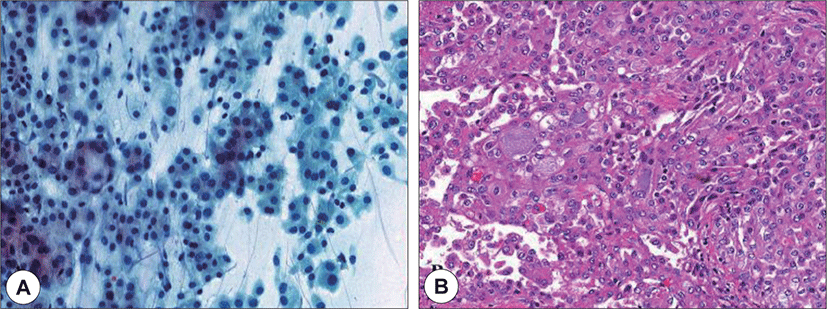
결 론
이번 종설에서 주요한 침샘종양들의 병리학적 소견 을 알아보았다. 앞서 언급한 것처럼 침샘종양은 알려져 있는 종류가 많으며 서로 유사한 병리학적 소견을 보여 서 세침흡인세포검사 및 조직검사를 통한 진단이 매우 어려운 분야이다. 특히, 악성종양은 무려 19종으로 분 류되지만 가장 흔하다고 알려진 점액유상피암종의 발 생 빈도가 침샘암의 30% 정도이며,20) 세엽세포암종이 18%,20) 선낭암종이 10%를 차지하며,6) 나머지 대부분의 아형들은 빈도가 높지 않아 병리의사가 충분한 경험을 쌓기 어려운 점도 진단이 힘든 이유 중 하나라고 생각 된다. 침샘종양을 진단할 때는 세포학적 소견뿐만 아니 라 종양세포가 어떠한 배열을 하는지, 주변조직과의 관 계는 어떠한지도 유심히 관찰해야 하는 부분이다. 따라 서, 그러한 구조적 소견을 관찰할 수 없는 세침흡인세 포검사에서는 일차적으로 양성종양과 악성종양을 구분 하는 데 목적이 있으며, 아형을 진단하기는 쉽지 않다. 여러 연구에 따르면 세침흡인세포검사의 정확성은 민 감도가 60~100%, 특이도가 90~100%에 이른다.10,21) 하 지만 정확한 아형을 진단하는 데는 한계가 있어서 연구 에 따라 62%에서 80%의 정확성이 보고된 바 있다.22,23) 따라서, 임상의사는 수술 전에 세침흡인검사와 함께 임 상 양상, 영상의학적 검사 결과 등을 종합하여 치료 계 획을 세우고 필요하다면 동결절편생검을 고려하여야 한다.
최근 들어 침샘종양에서 변이 유전자와 표지자가 새 롭게 밝혀지고 있다(Table 2).6,8,24) 다형선종에서 발생하 는 PLAG1 유전자의 전좌와 HMGA2 유전자의 재배열 이 대표적이다. 점액유상피암종에서는 MAML2 유전자 의 전좌, 선낭암종에서는 MYB 유전자의 전좌가 밝혀 졌다. 이 유전자들이 발현하는 단백질 중 PLAG1 단백 질과 MYB 단백질에 대한 항체가 개발되어 침샘종양의 진단에 표지자로 이용할 수 있게 되었다. 이 같은 유전 학적 변이에 대한 연구 결과가 축적되면 침샘종양의 병 태생리학적 특성을 명확히 파악하여 그에 따라 더 적절 한 분류가 가능해지고 표지자 발굴로 이어져서 진단에 도움을 받게 될 것으로 기대한다.
